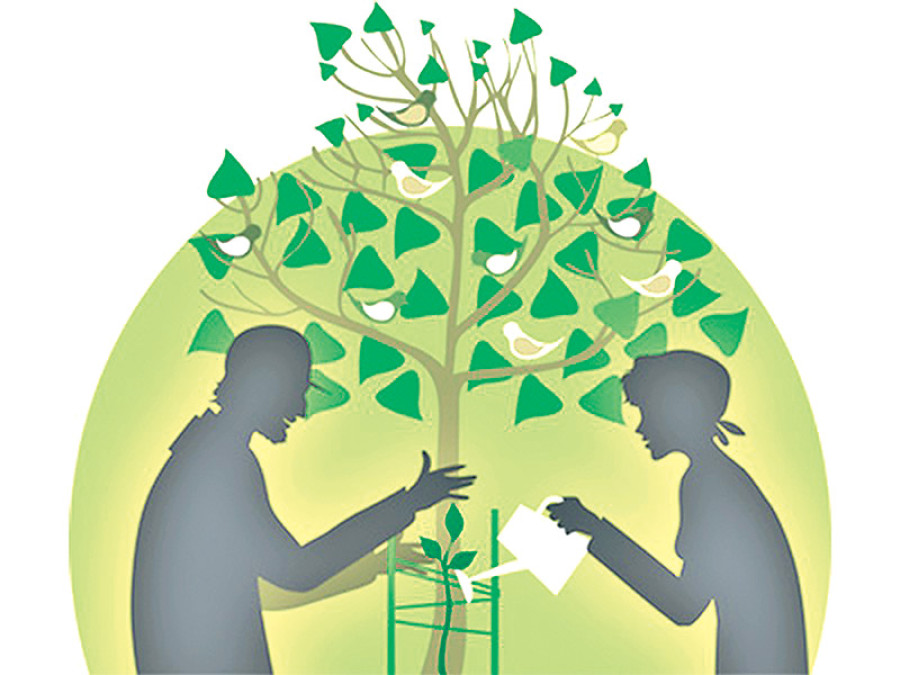Opinion
Lungs of Kathmandu
While going through the political parties’ manifestos for local elections, my attention was first drawn to agendas like the creation of community parks, plantation of trees and traffic management in Kathmandu Metropolitan City (KMC).
Bhawana Upadhyay
While going through the political parties’ manifestos for local elections, my attention was first drawn to agendas like the creation of community parks, plantation of trees and traffic management in Kathmandu Metropolitan City (KMC). With increasing urban sprawl in Kathmandu, immediate focus should be on the need for more open spaces and trees rather than the instalment of a monorail.
According to a KMC official, there is already a plan in place to build at least one park in each ward and expand the city’s green belt. However, the swelling population of squatters is already encroaching on public lands and river banks. Likewise, plantation of new saplings seems impossible on the increasingly narrowing sidewalks. Therefore, resources should be channelled towards conserving and maintaining the existing green spaces and replanting trees rather than embarking on unfeasible new projects. Preserving existing open spaces has been critical in Kathmandu where there is a burgeoning number of buildings and cars.
The city has been blessed with seven Unesco heritage sites and a decent number of open spaces, rendering the job of KMC easier in terms of conserving and maintaining rather than investing in new infrastructures. The significance of open spaces was realised in the aftermath of the 2015 earthquake, when many residents were forced to find refuge in them due to countless aftershocks. Open spaces like Basantapur Durbar Square, Tundikhel and Ratna Park served as temporary abodes for many during the aftermath of the quake.
Avoiding previous mistakes
Time and again, Kathmandu has witnessed trees being chopped down randomly for so-called traffic and security reasons. Kathmandu’s streets rejoiced and embraced the plantation of fresh saplings, shrubs and herbaceous plants in 2015 when the Valley was gearing up to host the 18th Saarc Summit. But that was not the first time such an initiative took place; Kathmandu also had blissful moments during the first Saarc summit in 1987 when the Valley was turned into a green garden.
The concept of tree plantation in urban areas started in the Rana dynasty. Jung Bahadur Rana, the founder of Rana dynasty, brought the idea back to Nepal following his visit to Europe. He initiated some tree planting activities in the Valley.
One initiative that Kathmandu Valley Development Authority (KVDA) successfully completed was the plantation programme to mark the world environment week in 2014. The programme covered about 350m, from Maitighar to Babar Mahal, and it was later extended to Tinkune. The KVDA engaged public and private institutions as a part of the greenery project. However, due to a lack of proper cooperation among partners and the public, the zeal to sustain the project faded away.
Though KVDA invested a considerable amount of resources to plant trees along the roadside, it failed to provide a proper mechanism to ensure regular maintenance for its sustainability. Local social workers are of the view that despite various efforts of non-government and private sector organisations towards promoting tree plantation in KMC, little has been achieved primarily due to the lack of awareness among the general public. Sights of pedestrians uprooting the saplings, stray animals munching on roadside plants, and locals throwing litter in the open spaces and turning them into garbage dumping sites are not unusual. It seems that we have lost respect for public goods. This knowledge gap has led to non-cooperation.
“A classic example of lack of coordination is clearly seen between the Department of Forest (DoF) and the Department of Road (DoR),” said one friend of mine who has been involved in silviculture. Instead of letting the DoF—the government entity responsible for silviculture—do its job, the DoR arbitrarily assumes the duty of planting and looking after trees lining the streets.
It’s important to appreciate the value of green spaces and trees as they help regulate micro climate, recharge groundwater, absorb solar radiation, filter dust particles and protect diverse species of birds and butterflies in the city. More importantly, green trees act as carbon sinks which in turn help to make Kathmandu a climate resilient and eco-friendly city.
Initiatives for partnership
The good news is that the civil society has made efforts towards enhancing greenery of the Valley. For instance, in July 2015, as part of the 75th week of the Bagmati River Cleaning Campaign, about 350 saplings of various tree species were planted on the banks of the river from Guheshwari to the Gothatar bridge. This initiative was led by the Pudasaini Friendship Society in coordination with the DoF, and the saplings were provided by the World Wildlife Fund (WWF).
Likewise, Citizens for Trees showed concern by questioning the government’s reluctance on undertaking initial environmental impact assessment and plan of replantation of trees before the start of the Ring Road widening project. They had campaigned against cutting trees along the Ring Road while the eight-lane highway was being built.
The campaigners encouraged the residents of Kathmandu to form the Chipko Nepal Movement to stop cutting down trees in the name of the road widening project. These tree lovers highlight the need to raise awareness among the urban population about the benefits of urban forestry. But urban forestry is about more than just planting trees; it’s about bringing forest ecology into urban planning with proper integrated management plans and resources.
June 5, the World Environment Day, seems to be the perfect day to make a commitment with a newly elected Mayor and his council members to align with the government announcement of the forest decade (2014-2023) to promote afforestation in public and private lands with the theme ‘one house one tree; one village one forest, and one town several parks’.
- Upadhyay writes on contemporary social issues, natural resources and sustainable development practices




 14.12°C Kathmandu
14.12°C Kathmandu










